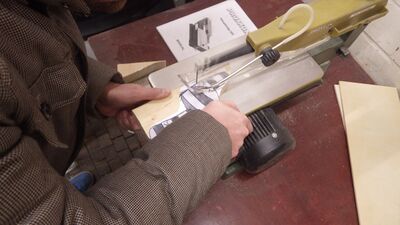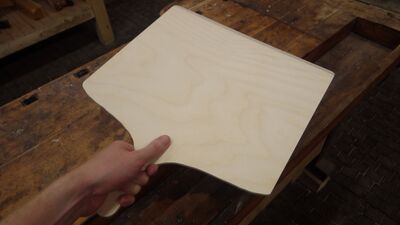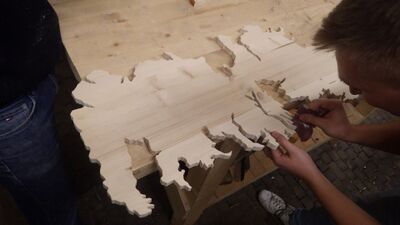Scroll Saw: Difference between revisions
NitramLegov (talk | contribs) New Tutor |
NitramLegov (talk | contribs) Added a nice picture while keeping the gif for the wiki |
||
| Line 1: | Line 1: | ||
=General Information= | |||
{{MachineInfoBox | {{MachineInfoBox | ||
|machine name= | |machine name=Scroll Saw | ||
|image=ScrollSaw.gif | |image=ScrollSaw.gif | ||
|synonyms="fretsaw machine"; DE: Dekupiersäge,<br>Feinschnittsäge | |synonyms="fretsaw machine"; DE: Dekupiersäge,<br>Feinschnittsäge | ||
| Line 8: | Line 9: | ||
|material=[[wood]], [[plastics]], non-ferrous [[metals]] | |material=[[wood]], [[plastics]], non-ferrous [[metals]] | ||
|tutors=[[Tutor::User:Lukas|Lukas]], [[Tutor::User:Mitja|Mitja]], [[Tutor::User:NitramLegov|Martin]], [[Tutor::User:Johannes|Johannes]] | |tutors=[[Tutor::User:Lukas|Lukas]], [[Tutor::User:Mitja|Mitja]], [[Tutor::User:NitramLegov|Martin]], [[Tutor::User:Johannes|Johannes]] | ||
|similar=[[fretsaw]], [[bandsaw]], ''[[Laser Cutter|laser cutter]]'' | |similar=[[fretsaw]], [[bandsaw]], ''[[Laser Cutter|laser cutter]]'' | ||
|status=Available | |status=Available | ||
|extrabox=yes | |||
}} | }} | ||
A scroll saw can be described as a powered [[fretsaw]]: two arms at the top and bottom hold a thin saw blade and vibrate quickly. The workpiece is pushed through the otherwise stationary saw blade to cut. It is a very versatile tool and can be used to cut [[wood]], [[plastics]] or many [[Material:Metal|metals]] to obtain intricate shapes. For larger pieces with wider curves you may want to use a [[jigsaw]]. | A scroll saw can be described as a powered [[fretsaw]]: two arms at the top and bottom hold a thin saw blade and vibrate quickly. The workpiece is pushed through the otherwise stationary saw blade to cut. It is a very versatile tool and can be used to cut [[wood]], [[plastics]] or many [[Material:Metal|metals]] to obtain intricate shapes. For larger pieces with wider curves you may want to use a [[jigsaw]]. | ||
[[File:scroll saw.JPG|thumb|300px|cutting parts for [[Project:Schneckchen]]|alt=|left]] | |||
<br clear="all" /> | |||
=Proxxon DHS= | |||
{{MachineInfoBox | |||
|machine name=Proxxon DSH | |||
|image=Scroll saw.JPG | |||
|synonyms="fretsaw machine"; DE: Dekupiersäge,<br>Feinschnittsäge | |||
|type=power tool/[[:Category:Saws|saw]] | |||
|access=[[Scroll Saw Introduction|scroll saw introduction]] | |||
|location=[[Location::Wood Workshop|wood workshop]] | |||
|material=[[wood]], [[plastics]], non-ferrous [[metals]] | |||
|manual=[https://images-eu.ssl-images-amazon.com/images/G/03/tools/PDF/B0017V817A.pdf amazon.com PDF] | |||
|similar=[[fretsaw]], [[bandsaw]], ''[[Laser Cutter|laser cutter]]'' | |||
|status=Available | |||
}} | |||
Cutting capacity is [[MaxSawCutDepthMillimeters::50]] mm in wood, 30 mm in plastics and 10 mm in non-ferrous metals.<sup> [https://www.proxxon.com/en/micromot/28092.php]</sup>{{#subobject:wood|@category=Saws|MaxSawCutDepthMillimeters=50}}{{#subobject:plastics|@category=Saws|MaxSawCutDepthMillimeters=30}}{{#subobject:non-ferrous metals|@category=Saws|MaxSawCutDepthMillimeters=10}} | Cutting capacity is [[MaxSawCutDepthMillimeters::50]] mm in wood, 30 mm in plastics and 10 mm in non-ferrous metals.<sup> [https://www.proxxon.com/en/micromot/28092.php]</sup>{{#subobject:wood|@category=Saws|MaxSawCutDepthMillimeters=50}}{{#subobject:plastics|@category=Saws|MaxSawCutDepthMillimeters=30}}{{#subobject:non-ferrous metals|@category=Saws|MaxSawCutDepthMillimeters=10}} | ||
Don't forget to wear [[Personal Protection|personal protection]] and hook up a [[Shop Vac|shop vac]] when you use it! | Don't forget to wear [[Personal Protection|personal protection]] and hook up a [[Shop Vac|shop vac]] when you use it! | ||
== Saw Blades == | == Saw Blades== | ||
Saw blades have to be changed frequently due to wear, different materials or simply because you want to cut a hole and have to enter the workpiece. | Saw blades have to be changed frequently due to wear, different materials or simply because you want to cut a hole and have to enter the workpiece. | ||
We use quick-release saw blades with pins on both ends, '''do not screw these in or they will break'''! Saw blades without pins have to be secured by screws on both arms of the machine. The teeth of the saw blade always have to point down and a hole will need to be at least '''5.3 mm''' in one direction for the blade to fit through because of these pins. | We use quick-release saw blades with pins on both ends, '''do not screw these in or they will break'''! Saw blades without pins have to be secured by screws on both arms of the machine. The teeth of the saw blade always have to point down and a hole will need to be at least '''5.3 mm''' in one direction for the blade to fit through because of these pins. | ||
=== Changing Saw Blades === | ===Changing Saw Blades=== | ||
* unplug the machine | *unplug the machine | ||
* turn the tensioner (knob in the back) counterclockwise to loosen | *turn the tensioner (knob in the back) counterclockwise to loosen | ||
* push the top arm down | *push the top arm down | ||
* unhinge the saw blade from the top and bottom arm | *unhinge the saw blade from the top and bottom arm | ||
* insert a new saw blade (teeth pointing down, pins carefully hooked in their grooves) | * insert a new saw blade (teeth pointing down, pins carefully hooked in their grooves) | ||
* turn the tensioner clockwise until the blade makes a high-pitch noise when plucked | *turn the tensioner clockwise until the blade makes a high-pitch noise when plucked | ||
* continue working | *continue working | ||
<br clear=right> | <br clear="right"> | ||
=== Types of Saw Blades === | ===Types of Saw Blades=== | ||
{{MaterialInfoBox | {{MaterialInfoBox | ||
|material name=Scroll Saw Blades | |material name=Scroll Saw Blades | ||
| Line 49: | Line 65: | ||
* coarse (10 teeth per inch/25 mm) | * coarse (10 teeth per inch/25 mm) | ||
** appropriate for soft and hard [[wood]] and ''thick materials'' | **appropriate for soft and hard [[wood]] and ''thick materials'' | ||
** Proxxon NO 28 741 | ** Proxxon NO 28 741 | ||
* normal (18 teeth per inch/25 mm) | *normal (18 teeth per inch/25 mm) | ||
** appropriate for soft and hard [[wood]], [[plastic]] and ''thin materials'' | ** appropriate for soft and hard [[wood]], [[plastic]] and ''thin materials'' | ||
** Proxxon NO 28 743 | **Proxxon NO 28 743 | ||
* fine (25 teeth per inch/25 mm) | *fine (25 teeth per inch/25 mm) | ||
** appropriate for [[plastic]], [[Material:GFRP|glass-fibre reinforced plastic]], non-ferrous [[metals]], [[Material:Acrylic Glass|acrylic glass]] and [[wood]] | **appropriate for [[plastic]], [[Material:GFRP|glass-fibre reinforced plastic]], non-ferrous [[metals]], [[Material:Acrylic Glass|acrylic glass]] and [[wood]] | ||
*** '''Caution with acrylic glass:''' the material tends to weld the cut closed due to the high temperature being generated and thus prevents backward motion - make sure you will be able to cut in one go or you might get stuck! Consider drilling relieve holes along the cutting path to allow for easy turning and exit points. Also cutting straight lines into acrylic glass tends to result in wave-like patterns as the blade is flexible and therefore oscillates around the cutting path. | ***'''Caution with acrylic glass:''' the material tends to weld the cut closed due to the high temperature being generated and thus prevents backward motion - make sure you will be able to cut in one go or you might get stuck! Consider drilling relieve holes along the cutting path to allow for easy turning and exit points. Also cutting straight lines into acrylic glass tends to result in wave-like patterns as the blade is flexible and therefore oscillates around the cutting path. | ||
** Proxxon NO 28 745 | **Proxxon NO 28 745 | ||
* <strike>round (16 teeth per cm)</strike> | *<strike>round (16 teeth per cm)</strike> | ||
** ''not in stock yet'' | **''not in stock yet'' | ||
** allow for free turning of the workpiece and very tight corners | ** allow for free turning of the workpiece and very tight corners | ||
** appropriate for [[plastic]] and soft or hard [[wood]] | ** appropriate for [[plastic]] and soft or hard [[wood]] | ||
** Proxxon NO 28 747 | **Proxxon NO 28 747 | ||
== Where to Cut? == | ==Where to Cut?== | ||
Even for a "free-hand" design you make your work easier if you sketch the cut on your workpiece, e.g. with a [[pencil]] on wood or a [[scriber]] on metal and plasic. For printed plans, the easiest option is to glue them onto the workpiece - with [[Glue Sticks|glue sticks]] (they're water soluble) or onto a layer of [[Masking Tape|masking tape]] which should later peel off without a trace. | Even for a "free-hand" design you make your work easier if you sketch the cut on your workpiece, e.g. with a [[pencil]] on wood or a [[scriber]] on metal and plasic. For printed plans, the easiest option is to glue them onto the workpiece - with [[Glue Sticks|glue sticks]] (they're water soluble) or onto a layer of [[Masking Tape|masking tape]] which should later peel off without a trace. | ||
== Inspiration == | == Inspiration== | ||
Here are some examples of [[projects]] you could use the scroll saw for: | Here are some examples of [[projects]] you could use the scroll saw for: | ||
<gallery mode=packed heights=150> | <gallery mode="packed" heights="150"> | ||
File:Tigerente Body Scrollsaw.jpg|link=[[Project:Tigerente]]|children's toys like a [[Project:Tigerente|''Tigerente'']] | File:Tigerente Body Scrollsaw.jpg|link=[[Project:Tigerente]]|children's toys like a [[Project:Tigerente|''Tigerente'']] | ||
File:pizzapeel-0.JPG|link=[[Project:Pizza Peel]]|simple [[Project:Pizza Peel|pizza peels]] | File:pizzapeel-0.JPG|link=[[Project:Pizza Peel]]|simple [[Project:Pizza Peel|pizza peels]] | ||
| Line 75: | Line 91: | ||
</gallery> | </gallery> | ||
<br clear=left> | <br clear="left"> | ||
* it's possible to [http://www.instructables.com/id/Nested-Helix/ cut spirals/helices] with the scroll saw (by hand or with a motorized jig) | *it's possible to [http://www.instructables.com/id/Nested-Helix/ cut spirals/helices] with the scroll saw (by hand or with a motorized jig) | ||
* (mostly German) collection of [http://www.heimwerker.de/bauanleitung/spiel-sport-und-freizeit/laubsaege-holzarbeiten.html project ideas & cutting plans] | *(mostly German) collection of [http://www.heimwerker.de/bauanleitung/spiel-sport-und-freizeit/laubsaege-holzarbeiten.html project ideas & cutting plans] | ||
== Repairs == | ==Repairs== | ||
We've had some mechanical issues with this saw over the years: | We've had some mechanical issues with this saw over the years: | ||
* 2020-10: loud noise due to the rotating counterweight hitting the bottom arm (near the motor) - fixed by Micha B | *2020-10: loud noise due to the rotating counterweight hitting the bottom arm (near the motor) - fixed by Micha B | ||
* 2021-5: tensioning screw losing contact to its nut [https://github.com/comakingspace/do-something/issues/227#issuecomment-846529373 due to a bent piece in the back] - fixed by {{P}} | *2021-5: tensioning screw losing contact to its nut [https://github.com/comakingspace/do-something/issues/227#issuecomment-846529373 due to a bent piece in the back] - fixed by {{P}} | ||
* ''potential next problem'': rubber collar around the tensioning screw ([https://github.com/comakingspace/do-something/issues/227#issuecomment-846529801 see issue comment]) | *''potential next problem'': rubber collar around the tensioning screw ([https://github.com/comakingspace/do-something/issues/227#issuecomment-846529801 see issue comment]) | ||
[[Category:Saws]] | [[Category:Saws]] | ||
[[Category:Woodworking]] | [[Category:Woodworking]] | ||
__SHOWFACTBOX__ | __SHOWFACTBOX__ | ||
Revision as of 23:26, 19 December 2021
General Information
| MachineInfoBox Scroll Saw | |
|---|---|
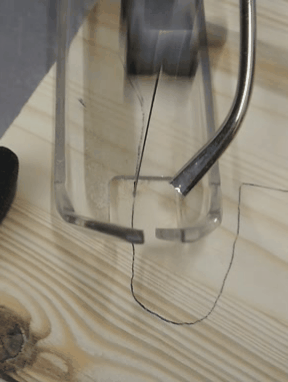
| |
| Synonyms: | "fretsaw machine"; DE: Dekupiersäge, Feinschnittsäge |
| Material: | wood, plastics, non-ferrous metals |
| Access Requirements: | The query description has an empty condition.Property "Needs Introduction" (as page type) with input value "The query description has an empty condition." contains invalid characters or is incomplete and therefore can cause unexpected results during a query or annotation process. |
| Tutors: | The query description has an empty condition. |
| Similar (More or Less): | fretsaw, bandsaw, laser cutter |
A scroll saw can be described as a powered fretsaw: two arms at the top and bottom hold a thin saw blade and vibrate quickly. The workpiece is pushed through the otherwise stationary saw blade to cut. It is a very versatile tool and can be used to cut wood, plastics or many metals to obtain intricate shapes. For larger pieces with wider curves you may want to use a jigsaw.
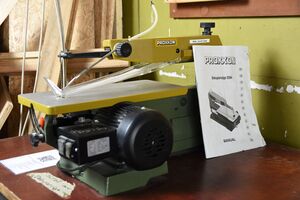
Proxxon DHS
| MachineInfoBox Proxxon DSH | |
|---|---|

| |
| Synonyms: | "fretsaw machine"; DE: Dekupiersäge, Feinschnittsäge |
| Material: | wood, plastics, non-ferrous metals |
| Access Requirements: | The query description has an empty condition.Property "Needs Introduction" (as page type) with input value "The query description has an empty condition." contains invalid characters or is incomplete and therefore can cause unexpected results during a query or annotation process. |
| Manual: | amazon.com PDF |
| Tutors: | The query description has an empty condition. |
| Similar (More or Less): | fretsaw, bandsaw, laser cutter |
... further resultsProperty "Has caption" (as page type) with input value "Vertical Bandsaws, Vertical Bandsaws, CNC Router, Mechanical Hand Tool, 3D Printers, 3D Printers, 3D Printers, 3D Printers, 3D Printers, 3D Printers, Oscilloscope, Oscillating Tool, Multimeter, Chop Saw, Wanted:Handheld Belt Sander, Bench Grinders, Bench Grinders, Table Saw, Handheld Circular Saws, Dust Extractors, Dust Extractors, Biscuit Joiner, Chop Saw, Handheld Circular Saws, CNC Router, Compressor, Archived:Corded Drills, Archived:Corded Drills, Cordless Drills, Cordless Disc Grinder, Cordless Drills, Jigsaws, Vice, Lab Power Supplies, Lab Power Supplies, Corded Disc Grinder, Corded Disc Grinder, Wood Lathes, CNC Mill, Wood Lathes, Laser Cutter, Eccentric Sanders, Kitchen Equipment, Chop Saw, Wood Lathe Accessory, Laser Printers, Audio Equipment, Audio Equipment, Wood Lathe Accessory, Wood Lathe Accessory[[:Special:Ask/-5B-5BHas-20Internal-20AssetID::+-5D-5D/-3FHas-20Internal-20Category/mainlabel=-2D/limit=50/offset=50/format=plainlist/link=none/headers=hide/default=Scroll-20Saw" contains invalid characters or is incomplete and therefore can cause unexpected results during a query or annotation process."{{{assetid}}}" is not a number.|]]
Cutting capacity is 50 mm in wood, 30 mm in plastics and 10 mm in non-ferrous metals. [1]
Don't forget to wear personal protection and hook up a shop vac when you use it!
Saw Blades
Saw blades have to be changed frequently due to wear, different materials or simply because you want to cut a hole and have to enter the workpiece.
We use quick-release saw blades with pins on both ends, do not screw these in or they will break! Saw blades without pins have to be secured by screws on both arms of the machine. The teeth of the saw blade always have to point down and a hole will need to be at least 5.3 mm in one direction for the blade to fit through because of these pins.
Changing Saw Blades
- unplug the machine
- turn the tensioner (knob in the back) counterclockwise to loosen
- push the top arm down
- unhinge the saw blade from the top and bottom arm
- insert a new saw blade (teeth pointing down, pins carefully hooked in their grooves)
- turn the tensioner clockwise until the blade makes a high-pitch noise when plucked
- continue working
Types of Saw Blades
| MaterialInfoBox Scroll Saw Blades | |
|---|---|
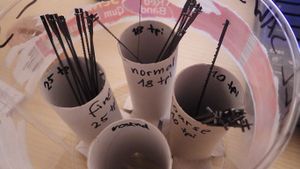
| |
| Synonyms: | DE: Dekupiersägeblätter |
| On Site? | soon |
| Location: | wall above scroll saw |
| Suggested Tools: | scroll saw |
Your material and to some extent also the design you want to cut dictate which saw blades can be used.
Our scroll saw works with 127 mm saw blades which come in different versions:
- coarse (10 teeth per inch/25 mm)
- appropriate for soft and hard wood and thick materials
- Proxxon NO 28 741
- normal (18 teeth per inch/25 mm)
- fine (25 teeth per inch/25 mm)
- appropriate for plastic, glass-fibre reinforced plastic, non-ferrous metals, acrylic glass and wood
- Caution with acrylic glass: the material tends to weld the cut closed due to the high temperature being generated and thus prevents backward motion - make sure you will be able to cut in one go or you might get stuck! Consider drilling relieve holes along the cutting path to allow for easy turning and exit points. Also cutting straight lines into acrylic glass tends to result in wave-like patterns as the blade is flexible and therefore oscillates around the cutting path.
- Proxxon NO 28 745
- appropriate for plastic, glass-fibre reinforced plastic, non-ferrous metals, acrylic glass and wood
round (16 teeth per cm)
Where to Cut?
Even for a "free-hand" design you make your work easier if you sketch the cut on your workpiece, e.g. with a pencil on wood or a scriber on metal and plasic. For printed plans, the easiest option is to glue them onto the workpiece - with glue sticks (they're water soluble) or onto a layer of masking tape which should later peel off without a trace.
Inspiration
Here are some examples of projects you could use the scroll saw for:
-
children's toys like a Tigerente
-
simple pizza peels
-
the "Game of Thrones" continent of Westeros
- it's possible to cut spirals/helices with the scroll saw (by hand or with a motorized jig)
- (mostly German) collection of project ideas & cutting plans
Repairs
We've had some mechanical issues with this saw over the years:
- 2020-10: loud noise due to the rotating counterweight hitting the bottom arm (near the motor) - fixed by Micha B
- 2021-5: tensioning screw losing contact to its nut due to a bent piece in the back - fixed by Patrick
- potential next problem: rubber collar around the tensioning screw (see issue comment)
